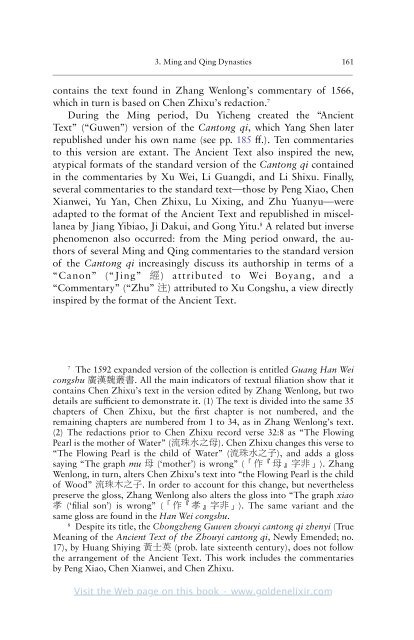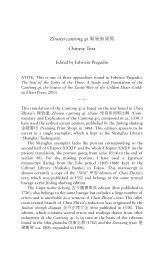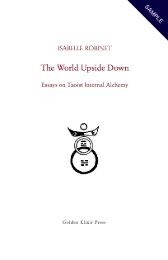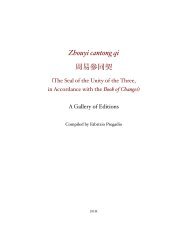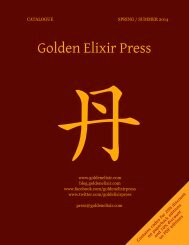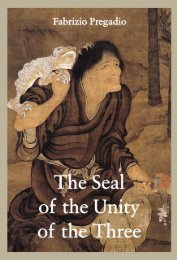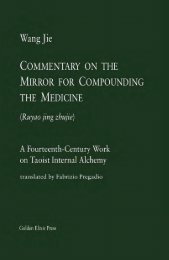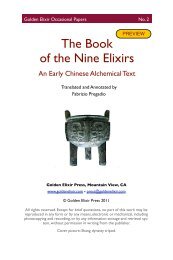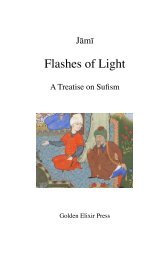The Seal of the Unity of the Three â Vol. 2 - The Golden Elixir
The Seal of the Unity of the Three â Vol. 2 - The Golden Elixir
The Seal of the Unity of the Three â Vol. 2 - The Golden Elixir
- No tags were found...
You also want an ePaper? Increase the reach of your titles
YUMPU automatically turns print PDFs into web optimized ePapers that Google loves.
3. Ming and Qing Dynasties 161<br />
—————————————————————————————————————————<br />
contains <strong>the</strong> text found in Zhang Wenlong’s commentary <strong>of</strong> 1566,<br />
which in turn is based on Chen Zhixu’s redaction. 7<br />
During <strong>the</strong> Ming period, Du Yicheng created <strong>the</strong> “Ancient<br />
Text” (“Guwen”) version <strong>of</strong> <strong>the</strong> Cantong qi, which Yang Shen later<br />
republished under his own name (see pp. 185 ff.). Ten commentaries<br />
to this version are extant. <strong>The</strong> Ancient Text also inspired <strong>the</strong> new,<br />
atypical formats <strong>of</strong> <strong>the</strong> standard version <strong>of</strong> <strong>the</strong> Cantong qi contained<br />
in <strong>the</strong> commentaries by Xu Wei, Li Guangdi, and Li Shixu. Finally,<br />
several commentaries to <strong>the</strong> standard text—those by Peng Xiao, Chen<br />
Xianwei, Yu Yan, Chen Zhixu, Lu Xixing, and Zhu Yuanyu—were<br />
adapted to <strong>the</strong> format <strong>of</strong> <strong>the</strong> Ancient Text and republished in miscellanea<br />
by Jiang Yibiao, Ji Dakui, and Gong Yitu. 8 A related but inverse<br />
phenomenon also occurred: from <strong>the</strong> Ming period onward, <strong>the</strong> authors<br />
<strong>of</strong> several Ming and Qing commentaries to <strong>the</strong> standard version<br />
<strong>of</strong> <strong>the</strong> Cantong qi increasingly discuss its authorship in terms <strong>of</strong> a<br />
“Canon” (“Jing” 經 ) attributed to Wei Boyang, and a<br />
“Commentary” (“Zhu” 注 ) attributed to Xu Congshu, a view directly<br />
inspired by <strong>the</strong> format <strong>of</strong> <strong>the</strong> Ancient Text.<br />
7<br />
<strong>The</strong> 1592 expanded version <strong>of</strong> <strong>the</strong> collection is entitled Guang Han Wei<br />
congshu 廣 漢 魏 叢 書 . All <strong>the</strong> main indicators <strong>of</strong> textual filiation show that it<br />
contains Chen Zhixu’s text in <strong>the</strong> version edited by Zhang Wenlong, but two<br />
details are sufficient to demonstrate it. (1) <strong>The</strong> text is divided into <strong>the</strong> same 35<br />
chapters <strong>of</strong> Chen Zhixu, but <strong>the</strong> first chapter is not numbered, and <strong>the</strong><br />
remaining chapters are numbered from 1 to 34, as in Zhang Wenlong’s text.<br />
(2) <strong>The</strong> redactions prior to Chen Zhixu record verse 32:8 as “<strong>The</strong> Flowing<br />
Pearl is <strong>the</strong> mo<strong>the</strong>r <strong>of</strong> Water” ( 流 珠 水 之 母 ). Chen Zhixu changes this verse to<br />
“<strong>The</strong> Flowing Pearl is <strong>the</strong> child <strong>of</strong> Water” ( 流 珠 水 之 子 ), and adds a gloss<br />
saying “<strong>The</strong> graph mu 母 (‘mo<strong>the</strong>r’) is wrong” (「 作 『 母 』 字 非 」). Zhang<br />
Wenlong, in turn, alters Chen Zhixu’s text into “<strong>the</strong> Flowing Pearl is <strong>the</strong> child<br />
<strong>of</strong> Wood” 流 珠 木 之 子 . In order to account for this change, but never<strong>the</strong>less<br />
preserve <strong>the</strong> gloss, Zhang Wenlong also alters <strong>the</strong> gloss into “<strong>The</strong> graph xiao<br />
孝 (‘filial son’) is wrong” (「 作 『 孝 』 字 非 」). <strong>The</strong> same variant and <strong>the</strong><br />
same gloss are found in <strong>the</strong> Han Wei congshu.<br />
8<br />
Despite its title, <strong>the</strong> Chongzheng Guwen zhouyi cantong qi zhenyi (True<br />
Meaning <strong>of</strong> <strong>the</strong> Ancient Text <strong>of</strong> <strong>the</strong> Zhouyi cantong qi, Newly Emended; no.<br />
17), by Huang Shiying 黃 士 英 (prob. late sixteenth century), does not follow<br />
<strong>the</strong> arrangement <strong>of</strong> <strong>the</strong> Ancient Text. This work includes <strong>the</strong> commentaries<br />
by Peng Xiao, Chen Xianwei, and Chen Zhixu.<br />
Visit <strong>the</strong> Web page on this book • www.goldenelixir.com


